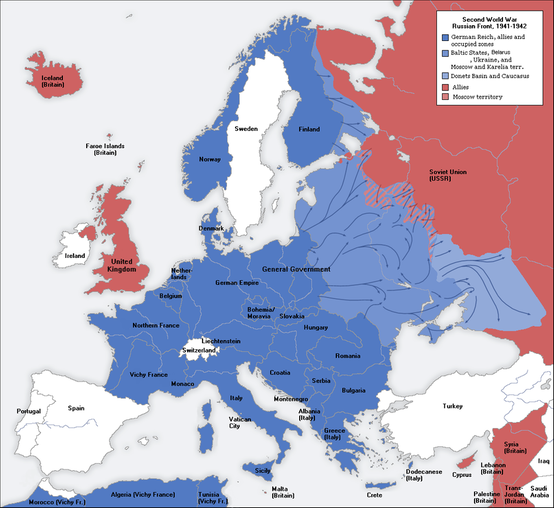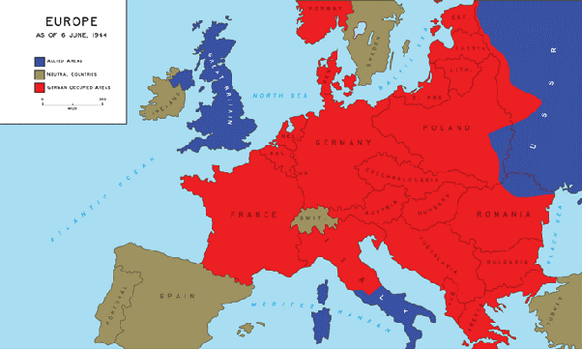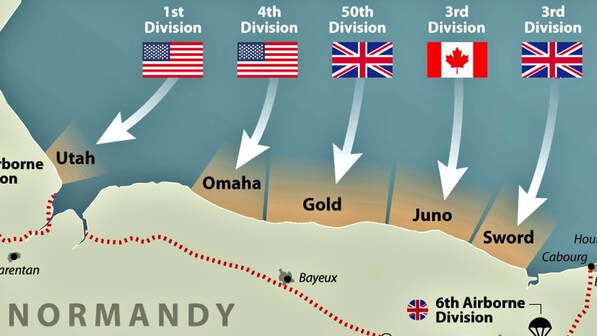The Second World War in Europe had been progressing in favour of Germany and the Axis powers since 1939. By 1942 they had dominated continental Europe, bringing most European countries under Nazi rule. The Allies required intense strategizing and replenishing of troops before they could attempt to regain any territory. Most of 1943 was focused on the Eastern front, and moving up Italy from the south. By mid 1944 they knew that it would be essential to reclaim France in order to close in on the Axis powers from all fronts. Although the course of the war seemed to be turning in favour of the Allies, they knew that Hitler's strong reign on France would be nearly unbreakable.
Planning for the invasion began in 1943. While many of the Canadian troops were concentrated on breaking through the Gothic Line in Italy, the allies knew that breaking through Hitler's Atlantic Wall would be essential for changing the course of the war. On the Axis side, General Erwin Rommel was commanding their forces. A very skilled military general, Rommel was well known for his astounding successes in North Africa. The Allies knew what they would be facing and decided that surprise would be their greatest weapon. With Operation Fortitude underway, June 5th, 1944 would be the prime opportunity for the allied forces to land in Normandy. With a full moon the night before, the men would not have to prepare for the invasion in total darkness, and the tides would be at the most suitable level to storm the beaches. However, due to poor weather conditions American General Dwight D. Eisenhower commanding the allied forces, was forced to call off the invasion.
The allied attack on Normandy referred to as Operation Overlord commenced with the beach landings on June 6th. They considered postponing the attack once again as the conditions were not ideal. However, another postponing would have meant waiting two to three weeks as only a couple of days in the month would have tides that were suitable to approach the beach. That way the element of surprise would surely have been lost. They set out just after midnight with the Americans landing on beaches Omaha and Utah, the British at beaches Gold and Sword, and the Canadians storming Juno Beach. Across the five Normandy beaches, stretching across 100 kilometres of coastline, more than 150,000 allied troops would land or parachute in on D Day.
More than 6,000 ships crossed the English Channel, approaching the French coastline in the hours before dawn. It was dark, as the skies were overcast. This did not allow for the early morning moon lit visibility hoped for by Eisenhower. However, it also meant the Germans were less suspecting of the attack and were therefore less prepared. The first allied troops to land in Normandy were the paratroopers who parachuted in behind enemy lines in the cover of dark in order to destroy communication and transportation targets, as well as German defenses. Unfortunately, many paratroopers drowned in the flooded marshlands and fields, weighted down by their equipment. The next wave of the attack was allied air strikes. Thousands of planes dropped bombs on the German defenses inland, and as the large warships approached the coast, they joined by bombing the beaches. The sun began to rise in the midst of the bombing, making way for the ships carrying over 100,000 troops, tanks, weapons and supplies to storm the Normandy beaches.
The Americans were the first to reach the beaches and the landing on Utah beach was generally successful. The American troops actually landed more than 1.8km away from their intended landing zone due to strong currents, but found that the area was less protected and they decided to start from there. The men were able to move approximately 6.4km in land by the end of the day. However, the Americans faced the largest resistance and the highest number of casualties at Omaha beach. This landing was significantly more difficult to achieve. The Americans struggled to cross the sands only to be faced with more impassable obstacles. A steep wall-like coastal cliff trapped them on the blood-stained beach away from their objectives. They were bombarded with enemy fire and suffered 300 casualties before even stepping off their boats. By the end of the day they had suffered 2400 casualties and of the five beaches they had made the least advances inland, approximately 2km.
At the middle of the five beaches, the British began storming Gold about an hour behind schedule due to the direction of the tides. However, thankfully for the troops, allied air strikes and bombing from the British warships earlier that morning had knocked out many of the German defenses. Within only an hour the British soldiers had secured beach exits and were able to push inland. At Sword, the easternmost beach, the British troops landed around 7:30am, approximately the same time as Gold. They faced more resistance but were still able to secure beach exits with the help of armoured vehicles. The worst resistance was in the farmlands and villages further in-land where not all of the German defenses had been destroyed by previous bombing. However, they were able to move inland approximately 8km. Overall the British landings were successful, they suffered approximately 2,750 total casualties. Although they did not reach their objectives, they were able to secure the beaches.
D Day would mark the first day of the Battle of Normandy over the summer of 1944 that resulted in the allied liberation of Western Europe. The Battle of Normandy is known as the "Beginning of the end of the war in Europe." The allied soldiers who landed on D Day pushed their way in land allowing for more troops to land over the following several days. By the middle of June more than a half a million allied soldiers would arrive in Normandy in order to push the German defenses out of France. It was not an easy task. By the end of the campaign the allies had suffered 209,000 casualties, including almost 19,000 Canadians. Germany also suffered approximately 200,000 casualties
Canada was a full partner in the success of the D Day landings. The Royal Canadian Navy contributed 110 ships and 10,000 men to support the landings. As well, the Royal Canadian Air Force assisted in the preparations by training not only Canadians, but thousands of other Commonwealth airmen. On D Day, 15 RCAF fighter and fighter-bomber squadrons participated in the allied air strikes in the early hours of June 6th. As a nation, Canada proved that they were willing to go to great lengths, and make great sacrifices in order to protect Western European civilization from Nazism.
__________________________________________________________________________________________________________________________
The 8th Hussars Museum & the Royal Canadian Legion Br. 20 are pleased to commemorate the 75th Anniversary of D Day with an event held on Thursday June 6th. Located at the Royal Canadian Legion Br. 20, 66 Magnolia Ave. Doors will open at 6:30pm, followed by the story of the D Day landings presented by Dr. Brian Clancy. The program is open to the public and there is no cover charge. The presentation will be suitable for students in Middle School and beyond. 75th Anniversary commemorative pins will be distributed to all attendees. We sincerely hope that you will join us in commemorating this historic event.
If you would like to find out more about the allied beach landings in Normandy or the Canadian involvement on D Day, please visit the 8th Hussars Museum in the Historic Sussex Train Station, 66 Broad Street.



